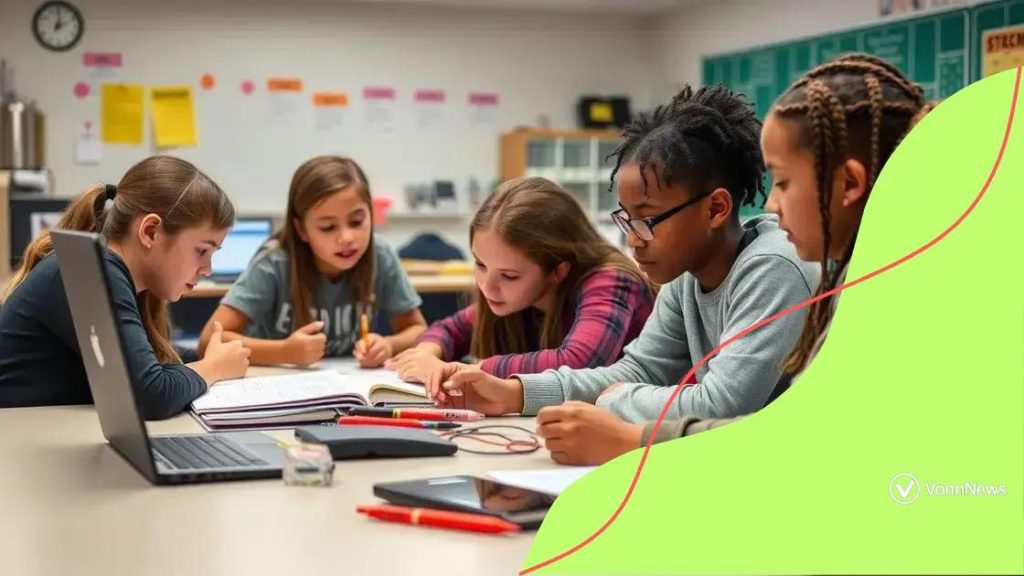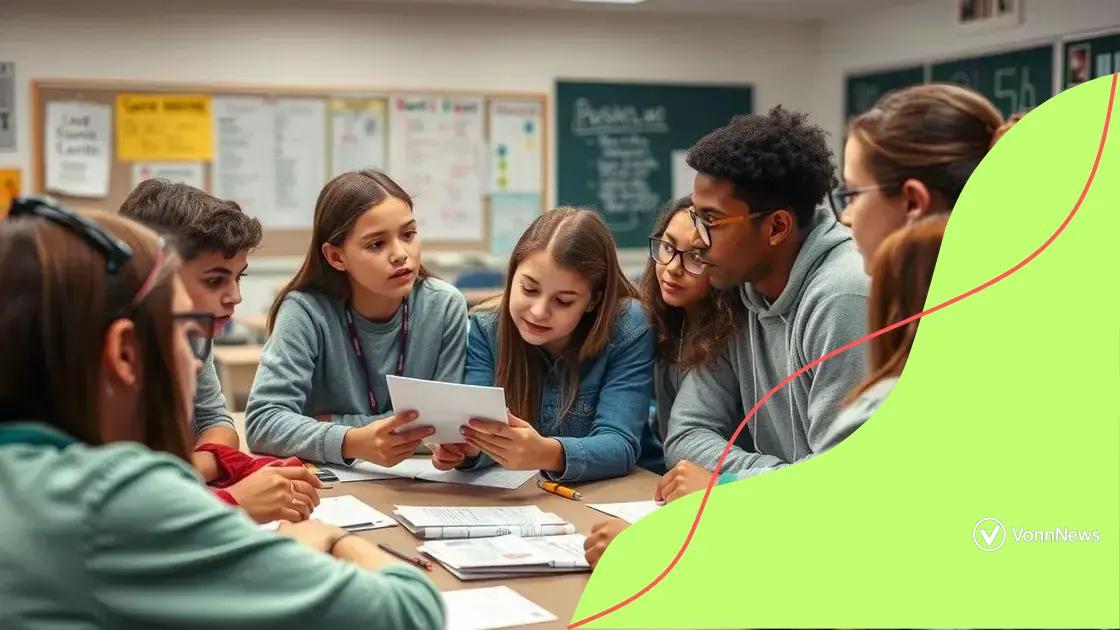Effectiveness of project-based learning: a deeper look

Anúncios
The effectiveness of project-based learning lies in its ability to actively engage students, fostering critical thinking, creativity, and collaboration, while measuring success through assessments and feedback to refine educational practices.
Effectiveness of project-based learning is a hot topic in education, as more teachers embrace this engaging method. Have you ever wondered how it impacts student outcomes? Let’s dive into the details.
Anúncios
Understanding project-based learning
Understanding project-based learning is essential for educators looking to engage students more deeply. This teaching method emphasizes real-world challenges and encourages students to actively participate in their learning.
In a project-based learning environment, students collaborate to solve problems, often leading to enhanced retention and understanding of the subject matter. By fostering teamwork, students learn to value each other’s opinions and skills.
Key Elements of Project-Based Learning
To successfully implement project-based learning, it’s vital to understand its core elements:
- Real-world context – Problems should be relevant to students’ lives.
- Student choice – Allowing students to choose projects increases engagement.
- Collaboration – Working in groups fosters communication skills.
- Reflection – Encouraging students to reflect helps solidify their learning.
These elements make project-based learning an effective approach. It shifts the classroom dynamic from teacher-centered to student-centered, promoting a more active and participatory learning environment.
Benefits for Students
Anúncios
The benefits of project-based learning are significant. Students not only gain knowledge but also develop critical thinking skills. For instance, when working on a project, they must analyze information, draw conclusions, and present findings to their peers.
This approach also prepares students for the real world by encouraging responsibility and self-management. They learn to meet deadlines and work collaboratively—all essential skills for future success.
As teachers observe the progress, they can see how students who engage in project-based learning are often more motivated and confident learners. This method aligns with various learning styles, making it inclusive.
Overall, understanding project-based learning equips educators with the tools to foster a more engaging and effective classroom experience.
Key benefits of project-based learning
The key benefits of project-based learning are profound and can significantly enhance students’ educational experiences. This method encourages active participation, critical thinking, and real-world application of knowledge.
One notable advantage is that project-based learning fosters deeper understanding. Students are not just passive recipients of information; they engage with the material in meaningful ways, leading to better retention.
Enhanced Engagement
When students work on projects, their engagement levels rise. They are more interested in learning because they see the relevance of their work. This method provides a sense of ownership over their learning, motivating them to explore topics in greater depth.
- Students are more likely to ask questions.
- They enjoy collaboration with peers.
- This approach reduces boredom and enhances participation.
Another benefit is the development of critical thinking skills. In project-based learning, students must analyze information, make decisions, and solve problems. This fosters a mindset that is prepared for real-life challenges, where they can apply what they’ve learned in practical situations.
Real-World Skills
Project-based learning also equips students with essential skills that go beyond academics. For example, they improve their communication abilities as they present their projects and work with group members. Learning to articulate ideas clearly is a valuable skill in any career.
Furthermore, students enhance their ability to collaborate effectively. Working in teams helps them learn to respect diverse viewpoints and negotiate solutions. This teamwork is not just academic; it mirrors the collaborative nature of many workplaces today.
Additionally, this method promotes creativity. Students are encouraged to think outside the box and come up with innovative solutions. They can express themselves in various ways, whether through art, writing, or presentations, adding a personal touch to their projects.
As a result, project-based learning cultivates not only knowledgeable students but also well-rounded individuals prepared for future success.
Challenges faced in project-based learning

While project-based learning offers numerous benefits, it also presents several challenges that educators must navigate. Recognizing these challenges can help teachers create more effective learning environments.
One significant hurdle is the need for proper planning. Successful project-based learning requires careful organization and clear objectives. Without a well-structured plan, projects may become chaotic, leading to frustration among students and teachers alike.
Resource Availability
Another challenge is the availability of resources. Some projects may require specific materials or technology that schools don’t have. This limitation can hinder creativity and limit the scope of projects. Teachers often need to find creative solutions to work around these constraints.
- Collaborating with local businesses for materials.
- Using recycled or low-cost items.
- Incorporating digital tools that are readily available.
Time management poses another difficulty in project-based learning. Projects often take longer than traditional lessons, which can disrupt the curriculum schedule. Teachers may struggle to fit projects into their already packed agendas. Setting realistic timelines and adapting the curriculum can help address this issue.
Student Participation
Moreover, ensuring all students participate actively can be challenging. Some may dominate the project while others remain passive. Teachers must foster an inclusive environment where every student feels valued and engaged. This may involve assigning specific roles or tasks to ensure equal contribution.
In addition, some students may find it difficult to adapt to the responsibility that comes with project-based learning. They might be accustomed to more traditional, directive teaching methods. Teachers can support these students by providing guidance and checkpoints throughout the project.
Lastly, assessing student performance in project-based learning can be complex. Standardized tests may not accurately reflect the skills and knowledge gained through projects. Teachers often need to develop new assessment strategies that capture both individual contributions and group outcomes.
Implementing project-based learning in classrooms
Implementing project-based learning in classrooms can transform the educational experience for both teachers and students. This method encourages students to take an active role in their learning process, making education more engaging and effective.
To start, teachers should identify the goals of the project. Clear objectives help in designing a project that is both relevant and interesting. It’s essential to align the project with curriculum standards and student interests. This connection increases motivation and ensures that the project meets educational requirements.
Creating a Supportive Environment
Next, creating a supportive environment is crucial. Students need to feel safe to express their ideas and take risks. An open classroom culture encourages collaboration and fosters creativity. Teachers can establish this atmosphere by promoting respect, inclusivity, and teamwork among students.
- Encourage students to share their thoughts openly.
- Facilitate group discussions to spark creativity.
- Recognize and celebrate teamwork.
Another important aspect of implementing project-based learning is integrating technology. Digital tools can enhance the learning experience, making projects more interactive. Teachers can utilize various resources, like online collaboration platforms or educational software, to support student work.
Flexible Grouping
Flexible grouping is also effective. Students can work in pairs, small groups, or independently based on the project’s needs. This varied approach allows learners to collaborate in diverse ways and can cater to different learning styles.
It’s important for teachers to regularly check in on group progress. Through ongoing assessments, teachers can identify challenges and provide timely feedback. This support helps steer students in the right direction, enhancing their learning experience.
Lastly, showcasing student work is vital. Presenting their projects lets students demonstrate their achievements. It also inspires others to engage in project-based learning. Invite parents or community members to view the projects, celebrating the hard work students have put in.
Measuring the effectiveness of project-based learning
Measuring the effectiveness of project-based learning is crucial for understanding how well it benefits students. Educators can use several methods to evaluate the outcomes of projects and the overall learning experience.
One effective approach is through assessment rubrics. Rubrics outline specific criteria that students must meet during their projects. This helps teachers objectively judge the quality of the work being produced. It is essential to communicate these criteria to students beforehand so they understand the expectations.
Formative Assessments
Another method is using formative assessments throughout the project. These assessments can include quizzes, reflections, or progress check-ins. They provide valuable insights into how students are grasping the material before completed projects are submitted.
- Quizzes can assess understanding of the subject matter.
- Reflection journals allow students to express what they’ve learned.
- Progress meetings can ensure teams stay on track.
Student self-assessment is also beneficial. Allowing students to evaluate their contributions encourages ownership of their learning. This practice can enhance their ability to critically reflect on their work and identify areas for improvement. Incorporating peer assessments further promotes collaboration and constructive feedback among group members.
Measuring Knowledge Retention
Additionally, measuring knowledge retention is essential to gauge the impact of project-based learning. Teachers can administer tests before and after projects to see if students retain more knowledge through hands-on experiences.
Moreover, observing student engagement is a key indicator of effectiveness. Higher levels of enthusiasm and participation often correlate with successful project-based learning. Teachers can track student interactions during group activities or presentations to understand their involvement and excitement.
Finally, reviewing student feedback can provide insights into their experiences with project-based learning. Surveys or informal discussions can reveal what students enjoyed and what challenges they faced. This feedback will help educators adjust their teaching methods for future projects, ensuring continuous improvement.
FAQ – Frequently Asked Questions about Project-Based Learning
What is project-based learning?
Project-based learning is an educational approach where students actively engage in projects to explore real-world challenges and problems.
How can project-based learning benefit students?
It enhances critical thinking, collaboration, and creativity, while also making learning more relevant and enjoyable.
What are some challenges of implementing project-based learning?
Challenges include resource availability, time management, student participation, and assessing project outcomes.
How can teachers measure the effectiveness of project-based learning?
Teachers can use assessments, student feedback, engagement levels, and knowledge retention tests to evaluate the effectiveness of the projects.